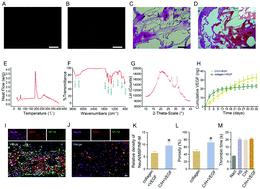当前位置:
X-MOL 学术
›
Biomater. Sci.
›
论文详情
Our official English website, www.x-mol.net, welcomes your
feedback! (Note: you will need to create a separate account there.)
Collagen/heparin scaffold combined with vascular endothelial growth factor promotes the repair of neurological function in rats with traumatic brain injury
Biomaterials Science ( IF 5.8 ) Pub Date : 2020-10-30 , DOI: 10.1039/c9bm01446b Jian Zhang 1, 2, 3, 4, 5 , Xiaoyin Liu 1, 2, 3, 4, 5 , Ke Ma 1, 2, 3, 4, 5 , Miao Chen 5, 6, 7, 8 , Huiyou Xu 1, 2, 3, 4, 5 , Xuegang Niu 5, 9, 10 , Haoran Gu 5, 11, 12 , Renjie Wang 1, 2, 3, 4, 5 , Xuyi Chen 1, 2, 3, 4, 5 , HongTao Sun 1, 2, 3, 4, 5
Biomaterials Science ( IF 5.8 ) Pub Date : 2020-10-30 , DOI: 10.1039/c9bm01446b Jian Zhang 1, 2, 3, 4, 5 , Xiaoyin Liu 1, 2, 3, 4, 5 , Ke Ma 1, 2, 3, 4, 5 , Miao Chen 5, 6, 7, 8 , Huiyou Xu 1, 2, 3, 4, 5 , Xuegang Niu 5, 9, 10 , Haoran Gu 5, 11, 12 , Renjie Wang 1, 2, 3, 4, 5 , Xuyi Chen 1, 2, 3, 4, 5 , HongTao Sun 1, 2, 3, 4, 5
Affiliation

|
The objective of this study was to evaluate the therapy effects of a novel biological scaffold containing heparin, collagen and vascular endothelial growth factor (VEGF) in treating traumatic brain injury (TBI). In our research, a functional composite scaffold constituted by collagen, heparin and vascular endothelial growth factor was used to stimulate angiogenesis and improve nerve-tissue regeneration in a rat model of TBI. The composite scaffold possessed excellent mechanical properties and good porosity, and could effectively control the release rate of VEGF. Motor and cognitive functions such as motor evoked potential, Morris water maze test and modified neurological severity score were evidently improved after the scaffold was grafted onto the injury site in the rat TBI model. There was clearly improved restoration of damaged nerve tissue at the injured site. Furthermore, brain edema and inflammatory reactions were significantly alleviated. Newly formed neurons with associated synaptic structures, nerve fibers, myelin sheaths and functional angiogenesis with intact endothelium at the injury site were observed. In conclusion, our data revealed that the collagen/heparin scaffold combined with VEGF could create excellent microenvironment stimuli for damaged nerve-tissue regeneration, providing a potential strategy for treating TBI.
中文翻译:

胶原/肝素支架联合血管内皮生长因子促进脑外伤大鼠神经功能的修复
这项研究的目的是评估一种新型的肝素,胶原蛋白和血管内皮生长因子(VEGF)的新型生物支架治疗创伤性脑损伤(TBI)的治疗效果。在我们的研究中,由胶原,肝素和血管内皮生长因子组成的功能性复合支架被用于刺激TBI大鼠模型中的血管生成并改善神经组织再生。该复合支架具有优异的力学性能和良好的孔隙率,可以有效地控制VEGF的释放速率。将支架移植到大鼠TBI模型的损伤部位后,运动和认知功能(例如运动诱发电位,Morris水迷宫测试和改良的神经系统严重程度评分)得到了明显改善。受损部位的受损神经组织的恢复明显得到改善。此外,脑水肿和炎症反应明显减轻。观察到新形成的神经元,其具有相关的突触结构,神经纤维,髓鞘和在损伤部位具有完整内皮的功能性血管生成。总之,我们的数据表明,胶原蛋白/肝素支架与VEGF结合可以为受损的神经组织再生创造出色的微环境刺激,为TBI的治疗提供了潜在的策略。
更新日期:2020-12-16
中文翻译:

胶原/肝素支架联合血管内皮生长因子促进脑外伤大鼠神经功能的修复
这项研究的目的是评估一种新型的肝素,胶原蛋白和血管内皮生长因子(VEGF)的新型生物支架治疗创伤性脑损伤(TBI)的治疗效果。在我们的研究中,由胶原,肝素和血管内皮生长因子组成的功能性复合支架被用于刺激TBI大鼠模型中的血管生成并改善神经组织再生。该复合支架具有优异的力学性能和良好的孔隙率,可以有效地控制VEGF的释放速率。将支架移植到大鼠TBI模型的损伤部位后,运动和认知功能(例如运动诱发电位,Morris水迷宫测试和改良的神经系统严重程度评分)得到了明显改善。受损部位的受损神经组织的恢复明显得到改善。此外,脑水肿和炎症反应明显减轻。观察到新形成的神经元,其具有相关的突触结构,神经纤维,髓鞘和在损伤部位具有完整内皮的功能性血管生成。总之,我们的数据表明,胶原蛋白/肝素支架与VEGF结合可以为受损的神经组织再生创造出色的微环境刺激,为TBI的治疗提供了潜在的策略。











































 京公网安备 11010802027423号
京公网安备 11010802027423号